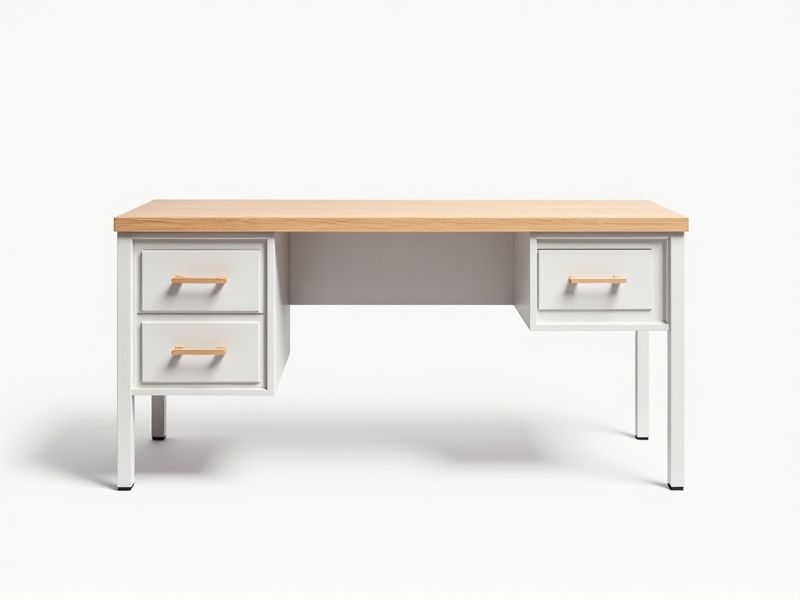
The standard dimensions for a typical office desk are usually around 48-60 inches (122-152 cm) wide, 24-30 inches (61-76 cm) deep, and 28-30 inches (71-76 cm) high. These measurements provide enough space for a computer, paperwork, and other essentials, while still fitting comfortably in most home or office environments. If you're setting up a workspace, you may want to consider both the available space and your ergonomic needs--like legroom and comfortable reach to your desk surface. Choosing the right dimensions ensures that your work area is both efficient and comfortable for daily use.
Desk Height
The standard desk height typically ranges from 28 to 30 inches, accommodating most users comfortably. Ergonomically, this height supports proper posture and minimizes strain on your back and neck. Adjustable desks, which can range from 24 to 50 inches in height, allow you to customize your workspace according to your needs. Consider your chair and monitor elevation to ensure an optimal ergonomic setup that promotes productivity.
Work Surface Width
The standard desk typically features a work surface width of 60 to 72 inches, offering ample space for various tasks. Many designs also prioritize a depth of 24 to 30 inches, ensuring comfortable use and adequate room for essential items like computers and paperwork. Ergonomics play a crucial role, as an optimal height range of 28 to 30 inches accommodates a majority of users. You may find that selecting a desk within these dimensions enhances your productivity and comfort during work hours.
Work Surface Depth
A standard desk typically features a work surface depth of 24 to 30 inches, allowing ample space for monitors, keyboards, and other essential tools. This depth is designed to accommodate various tasks, from writing to computer work, ensuring comfort and efficiency during prolonged use. Ergonomic considerations suggest that a desk height of 28 to 30 inches complements this depth for optimal posture. When choosing a desk, prioritize the work surface depth to enhance your overall productivity and workspace functionality.
Legroom Clearance
A standard desk typically requires a legroom clearance of at least 24 inches in height to ensure comfort for users. This space allows for unrestricted movement and accommodates various seating options, enhancing productivity during work hours. The recommended desk depth ranges from 24 to 30 inches, providing ample workspace while maintaining adequate leg space. Prioritizing ergonomic design, many models offer adjustable heights to further adapt to your personal needs and preferences.
Ergonomic Design
The standard desk emphasizes ergonomic design to enhance comfort and productivity during long working hours. With an adjustable height range of 24 to 50 inches, it accommodates various user preferences and promotes better posture. Features such as a spacious surface area of at least 48 inches wide allow ample space for your computer setup, documents, and personal items. Investing in an ergonomic desk can lead to a 20% increase in productivity and a significant reduction in work-related strain.
Material Quality
The standard of a desk significantly hinges on the quality of materials used, which directly affects durability and performance. For instance, high-grade hardwoods offer longevity and aesthetic appeal, while engineered woods provide cost-effective solutions without sacrificing strength. Think about opting for desks with a finish that resists scratches and stains, ensuring a polished look over time. Investing in a desk built with premium materials can enhance your workspace and contribute to a productive environment.
Weight Capacity
The standard weight capacity for a desk is typically between 100 to 200 pounds, accommodating various work materials and equipment seamlessly. Most ergonomic desks are designed to support multiple monitors, computer setups, and essential office supplies without compromising stability. High-quality materials often enhance durability, ensuring long-term use while maintaining a professional appearance. When choosing your desk, consider these weight limits to ensure optimal functionality and safety for your workspace.
Stability And Sturdiness
A standard desk typically prioritizes stability and sturdiness, ensuring it can support various tasks without wobbling or collapsing. With a weight capacity often ranging from 200 to 300 pounds, these desks accommodate multiple devices and materials, enhancing productivity. The construction usually incorporates durable materials such as solid wood or high-quality metal frames, which contribute to longevity. Investing in a standard desk that excels in these areas can significantly improve your workspace experience.
Adjustable Features
An adjustable desk typically offers a height range of 24 to 50 inches, accommodating various user preferences for sitting or standing positions. These desks can support weights of up to 250 pounds, ensuring stability and durability for your equipment. Many models feature programmable presets, allowing you to save preferred height settings for easy transitions throughout the day. Investing in an adjustable desk can enhance your ergonomic setup, promoting better posture and reducing discomfort during long work hours.
Cable Management Options
When selecting a standard desk, consider cable management options that enhance both organization and aesthetics. Desks equipped with integrated cable trays can accommodate up to 10 cables, ensuring a clutter-free workspace. Furthermore, desktop grommets allow for easy access while concealing wires, promoting a streamlined look. By investing in a desk with optimal cable management features, you can improve your productivity and create a more efficient work environment.
